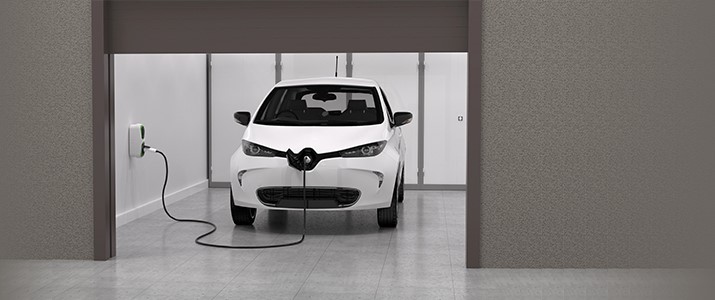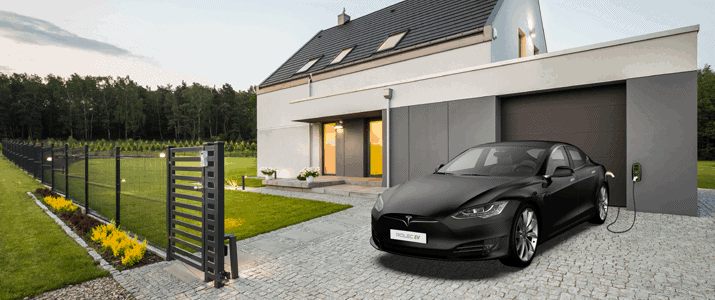Where Can You Install an Electric Vehicle Charging Station?
Page Contents
Written by qualified solar engineer Carlos. Last updated:
Electric vehicle charging stations are flexible devices that can be installed outdoors (on an exterior wall) or indoors (in your garage), inside your property. More and more people are learning how to charge their electric vehicles at home. It is needed in order to switch to a more sustainable, eco-friendly lifestyle.
If you’re looking to install an electric vehicle charging station in your home, it’s probably time to take a look at the best EV chargers for your needs. When picking one, there are several factors that should be taken into consideration. In this article, we’re going to discuss those factors. We’re also going to talk about how to understand charging levels and how to apply them to your needs. This will allow you to make a well-informed decision.
Know your EV
The first thing that you must know is the energy demand of your EV. This is a parameter that can be easily found in the datasheet or the specs of your electric car. Electric cars use DC batteries that can hold a maximum energy capacity once they are fully charged, this parameter is expressed in kWh. For instance, for the 2019 Kia Soul EV model, the battery capacity is 31.8kWh.
Understand the different EV charging station levels
The charging station acts simply as the point of transfer from the grid to your vehicle, however, almost all the charging process is actually performed inside the vehicle’s onboard charger. Inside this device, there is a conversion from alternating current (AC) to direct current (DC) through an electronic rectifier that allows charging the battery in DC.
Now, there are three categories of charging stations that are linked to the three levels of charge.
The first level of charge (level 1) is included with any electric car at the time of purchase. Under this level, the electric vehicle can be connected to any standard 120V AC wall outlet such as the NEMA 5-15 and can provide up to 3kW of power with an average charging speed of 8-16 hours. This charger uses a standard connector known as the J1772, which allows charging any electric vehicle.
The second level (level 2) needs to be installed with a charging station and connected to a 240V supply. This type of charger can provide from 3kW to 22kW of power (depending on the brand) with ampere ranges between 15A and 50A. Unlike the previous models, level 2 chargers can reduce charging times to 3-8 hours. This type of charging station will be the one that is most likely to be installed at your home since it allows you to increase the charging rate and can be installed at your home with small modifications. This charger type also uses the J1772 connector and can be installed either outside or inside the house (depending on the enclosure type of the charging station).
Finally, the third level is known as the DC Fast Charge (DCFC). This is the fastest charging station (as fast as 30 minutes) but is also the one with the highest costs. It also needs a 480V DC supply which is not available in most households, therefore, it is more suited for companies and commercial applications.
Choose the Corresponding Charging Station Level
Based on the two previous sections, you will be able to find out what is the minimum amount of hours that you need to charge your EV daily.
This can be done by using the kWh capacity of the battery and dividing it by the power output of the charger. For instance, the Siemens US2 level 2 charger has a 7.2kW power output. If we were to use this model to charge 2019 Kia Soul EV car, then we would need 31.8kWh/7.2kW=4.41 hours.

Based on this charging time and on your driving daily patterns, you will be able to know the type of charger that you will need. If by using a level 1 charger, you are missing time to fully charge it or to reach the required miles per day, then you will need to do an upgrade and install a level 2 model.
Adapting your site
Once you have decided on the type of charging level that you want to install at home (level 1 or 2), the next step is adapting your site. Depending on the EV charging station, you will be able to install it both indoor or outdoor, or only indoor. This is directly related to the enclosure type of the charger and cable. If it’s suited for outdoors, then it probably has a NEMA 4 type enclosure or higher as it prevents water from entering the charging station. If you are not familiar with the enclosure types, you must not worry as the manufacturer will always tell you if the charger is suitable for outdoor conditions (including rain and snow).

Enclosure types (Source – Clipper Creek)
If it is intended only for indoor use, then there is no other alternative than to install it inside the garage. Keep in mind that even if the charger needs to be installed indoors, you can still charge the car from the outside by running the 25-foot charging cable that the device is likely to have, it does not matter if it’s raining or not. This is useful to know for those who have enough room to install the indoor level 2 charger inside the garage, but not enough room to park the car inside. If you intend to do this, remember not to entirely close your garage; leave a small gap so the cable does not to suffer underneath the weight of the garage door.

Indoor EV charging station (Source – Rolecserv)
Meanwhile, for those cases in which both outdoor and indoor charging are possible and you choose to install outdoors, you should do a hardwire 240V installation because it provides the best weather protection for electrical power connections. A plug-in unit installed outdoor is also an option, but you must have a watertight cover for the plug and the outlet combination. The plug-in will have to be attached to a freestanding pole or an external wall as can be seen in figure 3.

External plug-in for EV charger (Source – Rolecserv)
No matter where you choose to install the EV charging station, inside or outside the garage, you will need a 240V outlet for level 2 chargers. For this purpose, it is recommended to adopt a dedicated circuit in the main electrical panel of the household. Keep in mind that in some cases, your main electrical panel may not have enough room to install the corresponding 2-pole breaker for the charger, therefore, you will need to install a separate panelboard. This also involves a dedicated conduit that runs from this panelboard to the EV supply equipment location. Additionally, you will need to add four new wires through the new conduit: a ground wire, common wire, and two phases which will be attached to the double-pole breaker. As you can see, it may become a demanding task. It would be best to hire a professional electrician who verifies that the building codes are met. Keep in mind that the EV charging station should always be mounted on concrete.
Finally, some charging stations will be able to communicate with local Wi-Fi networks or through ethernet cables. This communication is very important to manage the user interface and messaging for charging schedules. Therefore, when assessing the sites for the installation of the charging station, the availability of a good Wi-Fi signal should be considered in the scenario. If not available, especially in the garage, then considering signal repeaters would be wise.
References
- Siting and Design Guidelines for EVSE – NYSERDA
- EV Charger Installation Guide – EVSE Australia
- EV Charging: Indoor vs Outdoor, Weather Concerns – Clipper Creek
- What if you want to drive an electric vehicle but don’t have a garage? – MyEV
- 2019 Kia Soul EV Specifications – EV Specifications
We hope you liked this article. Please rate it or leave us a comment.
Average rating 5 / 5. Vote count: 5
No votes so far! Be the first to rate this post.





